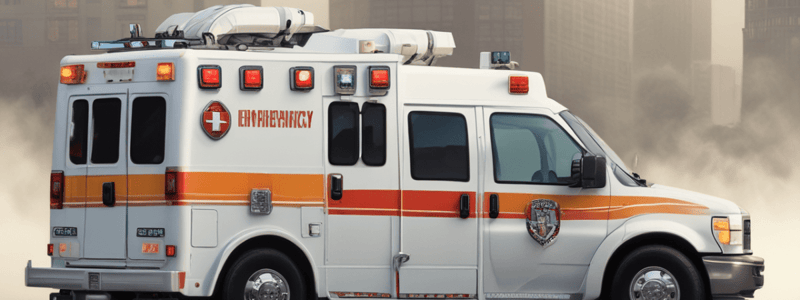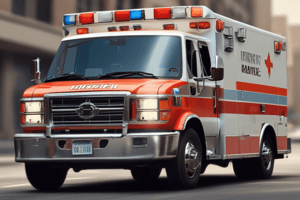Podcast
Questions and Answers
Who is exempt from wearing a seatbelt assembly in an ambulance?
Who is exempt from wearing a seatbelt assembly in an ambulance?
- Paramedics (correct)
- TFS personnel
- Patients
- All of the above
What should TFS personnel do while seated in the rear-facing seat in an ambulance?
What should TFS personnel do while seated in the rear-facing seat in an ambulance?
- Wear a seatbelt (correct)
- Brace themselves to prevent being thrown
- Provide patient care without a seatbelt
- Perform CPR
Who is responsible for a patient's care until responsibility is taken over by a higher medical authority?
Who is responsible for a patient's care until responsibility is taken over by a higher medical authority?
- TFS personnel (correct)
- Patients themselves
- Paramedics
- Operations Captains
What should TFS personnel do if a patient refuses medical attention?
What should TFS personnel do if a patient refuses medical attention?
Who has the authority to leave a patient once they have completed 'refusal of care' documentation?
Who has the authority to leave a patient once they have completed 'refusal of care' documentation?
What should TFS personnel do if a patient demands that they leave the premises?
What should TFS personnel do if a patient demands that they leave the premises?
What should be completed by TFS personnel in rare incidents?
What should be completed by TFS personnel in rare incidents?
Who is required to update Communications regarding a patient's concerns and status?
Who is required to update Communications regarding a patient's concerns and status?
What is the primary purpose of TFS Communications Centre in a medical call?
What is the primary purpose of TFS Communications Centre in a medical call?
What happens when Paramedic Services notify TFS Communications Centre of a call cancellation?
What happens when Paramedic Services notify TFS Communications Centre of a call cancellation?
What is the purpose of a Medical Check Call (MECC) event type?
What is the purpose of a Medical Check Call (MECC) event type?
What is the minimum time interval for reassessing vital signs in a medical call?
What is the minimum time interval for reassessing vital signs in a medical call?
What should TFS personnel do if a patient refuses treatment and/or assessment?
What should TFS personnel do if a patient refuses treatment and/or assessment?
How should multiple individuals or clients involved in an incident be documented in RMS?
How should multiple individuals or clients involved in an incident be documented in RMS?
What is the purpose of a Medical Assist (MEA) event type?
What is the purpose of a Medical Assist (MEA) event type?
What should TFS personnel do if they are in doubt about a patient's status?
What should TFS personnel do if they are in doubt about a patient's status?
What information should be excluded from the report in a medical call?
What information should be excluded from the report in a medical call?
What should TFS personnel do if they have made patient contact prior to notification of a call cancellation?
What should TFS personnel do if they have made patient contact prior to notification of a call cancellation?
Flashcards are hidden until you start studying
Study Notes
Riding in the Back of Ambulances
- Exemption from wearing seatbelts in the patient's compartment of an ambulance applies to paramedics and others attending to patients, where wearing a seatbelt is impractical.
- Toronto Fire Service (TFS) personnel riding in the back of ambulances follow the same policy as Paramedic Services.
Patient Management
- TFS personnel responding to medical emergencies are responsible for patient care until a higher medical authority takes over.
- TFS personnel should not leave patients who refuse medical attention; instead, they should update Communications regarding the patient's concerns and status.
- Paramedic Services personnel can leave a patient only after completing "refusal of care" documentation and a detailed patient examination.
Call Cancellation while En Route
- Paramedic Services may contact TFS Communications to cancel a response or downgrade a call priority.
- If notified, TFS Communications will cancel the responding apparatus.
- If TFS personnel have made patient contact, they should complete an assessment, communicate findings, and determine if a Paramedic Services response is still required.
Responding to Non-Obvious Patients
- TFS crews respond to non-obvious patients (e.g., Medical Assist, Medical Check Call, Medical Other, Medical Assist Non-Emergency) and conduct thorough primary and secondary assessments.
- Assessment includes taking vital signs, ascertaining patient details, and updating Communications with relevant information.
- Paramedics will respond, even if no unit is assigned; TFS will stay on scene, update Communications, and monitor patient condition.
Patient Assessment and Documentation
- Vital signs should be reassessed at a minimum of every 30 minutes, or every 10 minutes if the patient meets a medical directive.
- Documentation should include all patient findings, details, and circumstances, excluding patient names.
- Exceptions for documentation include accidental alarm activations and patients who abandon the scene.
Studying That Suits You
Use AI to generate personalized quizzes and flashcards to suit your learning preferences.




